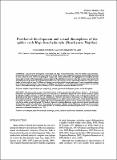Por favor, use este identificador para citar o enlazar a este item:
http://hdl.handle.net/10261/19120COMPARTIR / EXPORTAR:
 SHARE SHARE
 CORE
BASE CORE
BASE
|
|
| Visualizar otros formatos: MARC | Dublin Core | RDF | ORE | MODS | METS | DIDL | DATACITE | |

| Título: | Post-larval development and sexual dimorphism of the spider crab Maja brachydactyla (Brachyura: Majidae) |
Otros títulos: | Desarrollo postlarvario y dimorfismo sexual de Maja brachydactyla (Brachyura: Majidae) | Autor: | Guerao, Guillermo; Rotllant, Guiomar CSIC ORCID CVN | Palabras clave: | Majidae Maja brachydactyla Morphology Juvenile Post-larval development Growth Sexual dimorphism Morfología Juvenil Desarrollo postlarvario Crecimiento Dimorfismo sexual |
Fecha de publicación: | 30-dic-2009 | Editor: | Consejo Superior de Investigaciones Científicas (España) | Citación: | Scientia Marina 73(4): 797-808 (2009) | Resumen: | [EN] The post-larval development of the majid crab Maja brachydactyla Balss, 1922 was studied using laboratory-reared larvae obtained from adult individuals collected in the NE Atlantic. The morphology of the first juvenile stage is described in detail, while the most relevant morphological changes and sexual differentiation are highlighted for subsequent juvenile stages, until juvenile 8. The characteristic carapace spines of the adult phase are present in the first juvenile stage, though with great differences in the degree of development and relative size. The carapace shows a high length/weight ratio, which becomes similar to that of adults at stage 7-8. Males and females can be distinguished from juvenile stage 4, based on sexual dimorphism in the pleopods and the presence of gonopores. In addition, the allometric growth of the pleon is sex-dependent from juvenile stage 4, with females showing a positive allometry (b=1.23) and males an isometric allometry (b=1.02). [ES] El desarrollo postlarvario del májido Maja brachydactyla ha sido estudiado en el laboratorio después del cultivo larvario realizado a partir de individuos adultos capturados en el del Atlántico. La morfología del primer estadio juvenil se ha descrito en detalle y el desarrollo juvenil, hasta el estadio 8, ha sido estudiado en lo referente a los cambios morfológicos y la diferenciación sexual. En el primer juvenil, las espinas del cefalotórax características de los adultos están presentes, pero existen grandes diferencias en el grado de desarrollo y el tamaño relativo. cociente longitud/anchura muestra valores elevados que tienden a parecerse a los de los adultos a partir del juvenil 7-8. Machos y hembras se pueden diferenciar a partir del cuarto estadio juvenil, según el dimorfismo sexual en los pleópodos y la presencia de gonoporos. Además, existen diferencias sexuales en el crecimiento alométrico del pleon a partir del cuarto estadio juvenil: las hembras muestran una alometría positiva (b= 1.23) y los machos muestran un crecimiento isométrico (b= 1.02). |
Descripción: | 12 pages, 13 figures, 2 tables.-- Published online 8 Sept. 2009. | Versión del editor: | http://dx.doi.org/10.3989/scimar.2009.73n4797 | URI: | http://hdl.handle.net/10261/19120 | DOI: | 10.3989/scimar.2009.73n4797 | ISSN: | 0214-8358 | E-ISSN: | 1886-8134 |
| Aparece en las colecciones: | (CRAG) Artículos |
Ficheros en este ítem:
| Fichero | Descripción | Tamaño | Formato | |
|---|---|---|---|---|
| 1148.pdf | 6,89 MB | Adobe PDF |  Visualizar/Abrir |
CORE Recommender
SCOPUSTM
Citations
18
checked on 11-abr-2024
WEB OF SCIENCETM
Citations
15
checked on 20-feb-2024
Page view(s)
456
checked on 18-abr-2024
Download(s)
3.833
checked on 18-abr-2024
Google ScholarTM
Check
Altmetric
Altmetric
NOTA: Los ítems de Digital.CSIC están protegidos por copyright, con todos los derechos reservados, a menos que se indique lo contrario.
